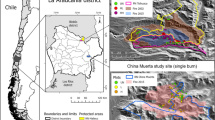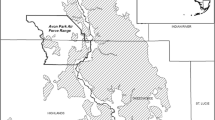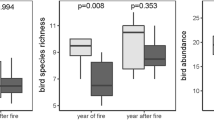Abstract
Overstorey shrub species are known to influence the composition of theunderstorey in Southern Hemisphere heathlands. Overstorey densities aresusceptible to variations in fire frequency; thus, fire regimes may influenceoverstorey/understorey interactions and overall floristic composition. Wecompared patches of Banksia heath which had supported anoverstorey during a fire interval of about 30 y with patches wherethe overstorey was absent during the same period, and tested for differences inspecies composition as a function of overstorey presence. Floristic compositionvaried significantly between overstorey patches and open patches. Most specieswere less abundant in overstorey patches, however some were more abundant. Therelative abundance of species in relation to overstorey was unrelated to theirfire response, propagule longevity or propagule storage location. There wassignificantly less biomass in overstorey patches compared with open patches.Theeffect of the overstorey varied with soil moisture. In a dry area, the numberof species was lower in overstorey patches, with fewer herb and shrub speciespresent compared with open patches. Fewer species were recorded in a wetterarea, but overstorey had no effect on the number of species recorded. Reducedintensity of competition among understorey species in overstorey patches couldbe responsible for the higher abundance of some species in these patches. Wepostulate that full diversity will be maintained when the density of overstoreyshrubs fluctuates widely over a relatively short period of time. This is mostlikely when fire frequency is highly variable.
Similar content being viewed by others
References
Auld T.D. 1986. Population dynamics of the shrub Acacia suaveolens(Sm.) Willd.: Dispersal and the dynamics of the soil seedbank. Australian Journal of Ecology 11: 235-254.
Auld T.D. 1996. Ecology of the Fabaceae in the Sydney region: fire, ants and the soil seedbank. Cunninghamia 4: 531-552.
Auld T.D. and O'Connell M.A. 1991. Predicting patterns of post-fire germination in 35 eastern Australian Fabaceae. Australian Journal of Ecology 16: 53-70.
Beadle N.C.W. 1940. Soil temperatures during forest fires and their effect on the survival of vegetation. Journal of Ecology 28: 180-192.
Bond W.J. and van Wilgen B.W. 1996. Fire and Plants. Chapman and Hall, London.
Bradstock R.A. and Myerscough P.J. 1981. Fire effects on seed release and the emergence and establishment of seedlings in Banksia ericifoliaL.f. Australian Journal of Botany 29: 521-531.
Bradstock R.A. and O'Connell M.A. 1988. Demography of woody plants in relation to fire: Banksia ericifoliaL.f. and Petrophile pulchella(Shrad.) R. Br. Australian Journal of Ecology 13: 508-18.
Bradstock R.A., Keith D.A. and Auld T.D. 1995. Fire and conservation: imperatives and constraints on managing for diversity.In: Bradstock R.A., Auld T.D., Keith D.A., Kingsford R.T., Lunney D. and Sivertsen D.P. (eds), Conserving Biodiversity: Threats and Solutions. Surrey Beatty and Sons, Sydney, pp. 323-333.
Bradstock R.A., Bedward M., Scott J. and Keith D.A. 1996. Simulation of the effect of spatial and temporal variation in fire regimes on the population viability of a Banksiaspecies. Conservation Biology 10: 776-784.
Bradstock R.A., Tozer M.G. and Keith D.A. 1997. Effects of high frequency fire on floristic composition and abundance in a fireprone heathland near Sydney. Australian Journal of Botany 45: 641-655.
Cary G.J. and Morrison D.A. 1995. Effects of fire frequency on plant species composition of sandstone communities in the Sydney region: Combinations of inter-fire intervals. Australian Journal of Ecology 20: 418-426.
Clarke K.R. 1993. Non-parametric multivariate analyses of changes in community structure. Australian Journal of Ecology 18: 117-143.
Clarke K.R. and Green R.H. 1988. Statistical design and analysis for a "biological effects' study. Marine Ecology Progress Series 46: 213-226.
Clarke K.R. and Warwick R.M. 1994. Change in Marine Communities: An approach to statistical analysis and interpretation.Natural Environmental Research Council, United Kingdom.
Clemens J. and Franklin M.H. 1980. A description of coastal heath at North Head, Sydney Harbour National Park: impact of recreation and other disturbance since 1951. Australian Journal of Botany 28: 463-478.
Connell J.H. 1978. Diversity in tropical rainforests and coral reefs. Science 199: 1302-1310.
Cowling R.M. and Gxaba T. 1990. Effects of a fynbos overstorey shrub on understorey community structure: implications for the maintenance of community-wide species richness. South African Journal of Ecology 1: 1-7.
Cowling R.M. and Holmes P.M. 1992. Flora and Vegetation. In: Cowling R.M. (ed.), The Ecology of Fynbos: Nutrients, Fire and Diversity. Oxford University Press, Cape Town, pp. 23-61.
Gill A.M. and McCarthy M.C. 1998. Intervals between prescribed fires in Australia: what intrinsic variation should apply? Biological Conservation 85: 161-169.
Hamill K., Bradstock R.A. and Allaway W.G. 1998. Post-fire seed dispersal and species re-establishment in proteaceous heath. Australian Journal of Botany 46: 407-419.
Harden G.J. (ed.) 1990-1993. Flora of New South Wales. New South Wales University Press, Kensington, Australia.
Hobbs R.J. and Huenneke L.F. 1992. Disturbance, diversity and invasion: implications for conservation. Conservation Biology 6: 324-337.
Huston M. 1979. A general hypothesis of species diversity. The American Naturalist 113: 81-101.
Keith D.A. 1991. Coexistence and species diversity of upland swamp vegetation: The roles of an environmental gradient and recurring fires. PhD Dissertation, University of Sydney.
Keith D.A. 1995. Mosaics in Sydney heathland vegetation: the roles of fire, competition and soils. CALM Science Supplement 4: 199-205.
Keith D.K. 1996. Fire-driven extinction of plant populations: a synthesis of theory and review of evidence from Australian vegetation. In: Proceedings of the Linnean Society of New South Wales, pp. 37-78.
Keith D.A. and Bradstock R.A. 1994. Fire and competition in Australian heath: a conceptual model and field investigations. Journal of Vegetation Science 5: 347-354.
Keith D.A. and Myerscough P.J. 1993. Floristics and soil relations of upland swamp vegetation near Sydney. Australian Journal of Ecology 18: 325-344.
Lamont B.B., Hopkins A.J.M. and Hnatiuk R.J. 1982. The flora - composition, diversity and origins. In: Pate J.S. and Beard J.S. (eds), Kwongan: Plant Life of the Sandplain. University of Western Australia Press, Western Australia, pp. 27-50.
Morris E.C. and Myerscough P.J. 1983. Banksia ericifoliatransgresses the self-thinning boundary. Australian Journal of Ecology 8: 199-201.
Morrison D.A., Cary G.J., Pengelly S.M., Ross D.G., Mullins B.J., Thomas C.R. et al. 1995. Effects of fire frequency on plant species composition of sandstone communities in the Sydney region: Inter-fire interval and time-since-fire. Australian Journal of Ecology 20: 239-247.
Siddiqi M.Y., Carolin R.C. and Myerscough P.J. 1976. Studies in the ecology of coastal heath in NSW. IV. Seed survival, germination, seedling establishment and early growth in Banksia serratifoliaSalisb., B. aspleniifoliaSalisb. and B. ericifoliaL.f. in relation to fire, temperature and nutrition. Australian Journal of Ecology 1: 175-183.
Specht R.L. and Specht A. 1989. Species richness of sclerophyll heathy plant communities in Australia - the influence of overstorey cover. Australian Journal of Botany 37: 337-350.
Underwood A.J. 1981. Techniques of analysis of variance in experimental marine biology and ecology. Oceanography and Marine Biology: Annual Review 19: 513-605.
Westhoff V. and van der Maarel E. 1978. The Braun-Blanquet approach. In: Whittaker R.H. (ed.), Classification of Plant Communities. Junk, The Hague, pp. 287-328.
Author information
Authors and Affiliations
Corresponding author
Rights and permissions
About this article
Cite this article
Tozer, M., Bradstock, R. Fire-mediated effects of overstorey on plant species diversity and abundance in an eastern Australian heath. Plant Ecology 164, 213–223 (2003). https://doi.org/10.1023/A:1021387210745
Issue Date:
DOI: https://doi.org/10.1023/A:1021387210745




